Structure and Properties of Matter - Each atom has a charged substructure consisting of a nucleus, which is made of protons and neutrons,surrounded by electrons.
Structure and Properties of Matter - Each atom has a charged substructure consisting of a nucleus, which is made of protons and neutrons,surrounded by electrons.: Overview
This topic covers various concepts like Atom, , etc.
Important Questions on Structure and Properties of Matter - Each atom has a charged substructure consisting of a nucleus, which is made of protons and neutrons,surrounded by electrons.
Calculate the maximum number of electrons in st, nd, rd and th shells.
Explain how the Bohr's atomic model was contradictory to Heisenberg's uncertainty principle.
Describe J. J. Thomson's atomic model.
If Rutherford's atomic model is correct, then the atom should collapse. Why?
What are orbits and why are they called stationary orbits?
How will you find out the maximum number of electrons in the main energy level?
In iron, the differentiating electron enters into the orbital of a penultimate shell.
and are isotopes while and are isobars.
How many orbitals are there in and shells? What are they?
ray scattering experiment proved that the positive particles are present in the extra nuclear part of an atom.
How are the subatomic particles arranged in an atom according to modern structure of the atom?
What happens when an electron jumps from a lower energy level to a higher energy level?
Who discovered protons? Based on what experiment was he able to discover these protons?
Give the mass and charge of fundamental particles of an atom.
Who invented protons?
The mass of positively charged particles present in an atom is found to be times that of an electron. Identify the element and write its electronic configuration.
A compound, on analysis, gave the following percentage composition :
What would be the molecular formula of the compound assuming that all the hydrogen in the compound is reset in combination with oxygen as water of crystallisation. Molecular weight of the compound is .
An atom has electronic configuration .
(a) What is the atomic number of this element ?
(b) Which of the following elements would be similar in chemical properties?
Which of the following options shows the correct set of atomic numbers and valency for element X in a neutral state as given below?

Explain with example: Mass number
